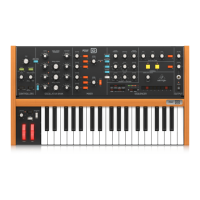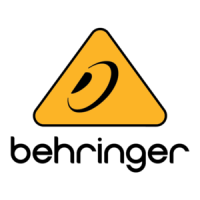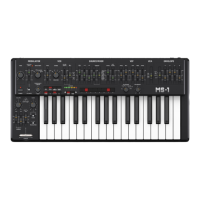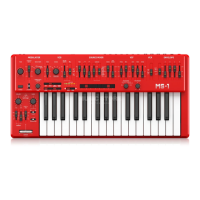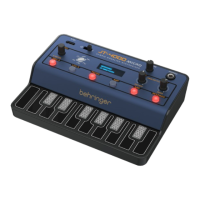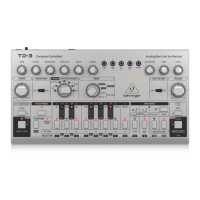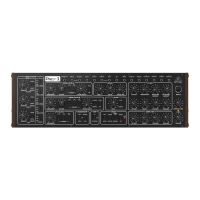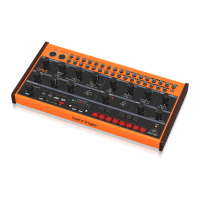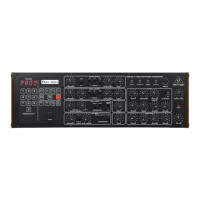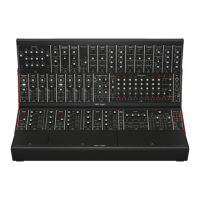37 MODEL D User Manual
Eect: One of a number of audio processes that can be applied to a signal to
modify it, such as reverb, anging, phasing, delay etc.
Eects Send: A copy of the channel signal which is sent to an eects processor
in order for it to be returned.
Eects Return: An eected audio signal which is returned to mix with the
original channel signal.
Envelope Generator (EG): An envelope signal which can be adjusted to a
specic shape in order to control the way a sound behaves over time.
Equalisation (EQ): Processor used to adjust the volumes of various frequency
ranges for creative or corrective purposes.
Exponential: A mathematical function of growth or decay where the
independent variable is the exponent. This results in a "hockey stick"
shaped curve.
Expression Pedal: A Pedal which can be connected to an expression input and
used to send a control signal dependant on the position of the pedal. The control
signal can then be used to modulate other parameters, and/or to add expression.
Fader: A physical linear control also known as a slider, or slide potentiometer
which can be used to adjust a parameter.
Feedback: A loop created between an audio input and an audio output of an
audio circuit, system or processing block.
Filter: A device that attenuates certain frequencies while letting other
frequencies through. Using a lter to reduce harmonics, changes the timbre or
color of the sound.
Frequency Modulation (FM): Using one frequency to modulate another
frequency's pitch. When the modulation source is in the audio range, it can be
perceived as a change in the timbre or color of the sound. FM can be used to
create a wide range of rich and complex sounds and is often described as having
a clear and distinctive timbre.
Frequency: The number of times that a sound waves cycle repeats within
onesecond.
Fundamental Frequency: The lowest frequency of a periodic waveform.
Gain: The amount of signal level increase provided by an amplier stage.
Gate (Synthesizer): A signal used to trigger an event, such as a note
or an envelope.
Gate (Dynamics): A device used to cut o the level of a signal when it falls
below a specied threshold. Can be used to cut background noise, control reverb
tails, or creatively to produce chopping type eects.
Glide: See Portamento.
Global: The settings and parameters which govern the general operation of the
synthesizer and are not directly associated with the voice engines.
Harmonics: A series of integer-related sine waves at varying levels creating
dierent timbres. Waveforms (other than a pure sinusoidal) generate various
harmonics which help dene the character of the sound.
Hertz (Hz): A unit of frequency equal to one cycle of a wave per second.
High Pass Filter (HPF): A lter that attenuates lower frequencies from a signal,
leaving the higher frequencies unaected.
Hum: Undesirable low-frequency tone (typically 50 or 60 Hz) present in a signal
due to grounding problems or proximity to a power source or power cables.
Impedance (Z): Opposition to the ow of alternating current in a circuit,
measured in Ohms.
Insert: A point in a processing chain where a device can be inserted.
Keyboard: A range of keys, arranged in order of ascending pitch, which enables
the synthesizer to be played by hand.
Keyboard Tracking: Allows the control signal from played keys to adjust
another parameter. Commonly used to open a lter as higher notes are played
which then enhances harmonics.
Kilohertz (kHz): A unit of frequency equal to one thousand cycles of a
wave per second.
Latency: A delay introduced by processing. Measured by the time it takes to
produce a signal after a request has been made. In a synthesizer, it is the time
taken to produce a note after a key has been played. In an audio interface, it is
used to measure the time it takes for an input signal to reach the processor, or for
a signal from the processor to reach the output.
Level: Used to describe the magnitude of a sound, often relative to an
arbitrary reference.
Limiter: A device used to limit the level to a range of values irrespective of the
input level.
Linear: Used in audio to describe a straight line response of circuit or
process which results in a change which is directly proportional to an
independent variable.
Line Level: A nominal operating level used by audio equipment. Professional
line level is normally +4 dBu and consumer line level is -10 dBv.
Looping: Automatically restarting a function at the end of a period of time or
dened cycle, to create a continuous loop.
Low Frequency Oscillator (LFO): An oscillator that commonly runs at a very
low speed and is used to modulate another parameter.
Low Pass Filter (LPF): A lter that attenuates higher frequencies from a signal,
leaving the lower frequencies unaected.
Mark to Space Ratio: The ratio between the positive and negative parts of a
rectangular waveform, or pulsewave.
Meter: Visual device to indicate the level of a signal.
MIDI (Musical Instrument Digital Interface): A technical standard that
describes a protocol, digital interface and connectors and allows a wide variety of
electronic musical instruments, computers and other related hardware/software
devices to connect and communicate.
MIDI Clock: A clock signal which is broadcast over MIDI to ensure that devices are
synchronised. Also known as MIDI Beat Clock or MIDI Timing Clock.
MIDI Message: Data or information transmitted from one MIDI device to
another. Each MIDI message contains at least two numbers: one that identies
the type of message being sent, and another which represents a value for the
selected type of message.
Midrange: Frequencies in a signal ranging from 250 Hz to 5 kHz
(Approximately B3 to D#8).
Mix: The balance of level between one signal and another.
Mixer: A device that blends input signals into composite signals for output.
Modular Synthesis: A synthesis system comprised of a number of modules
which can be connected in many dierent ways. Modules can perform a single
function such as an oscillator or lter or perform multiple functions.
Modulation: The process of controlling one or more properties (destinations) of
a signal using another signal (source).
Modulation Wheel (Mod Wheel): A wheel located to the left of a keyboard
that allows you to change specied parameters in real-time.

